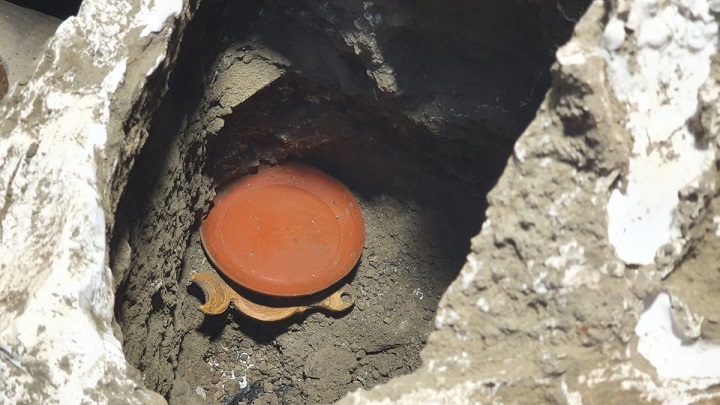
Small furnished rooms with rare findings were discovered at the House of the Lararium in the ruins of Pompeii, shedding light on the everyday life of the middle and low class Roman citizens around the time of Mount Vesuvius’s furious eruption which buried the ancient city in volcanic debris in AD 79.
The site, located at the northern area of the so-called Regio V, one of the largest districts of Pompeii, was previously excavated in 2018. Three years later, archaeologists returned to investigate the rooms on the ground floor and the first floor.
Among the precious objects that emerged were a beautifully decorated incense burner and a double-ended lantern; vessels with orante attachments; and a two-meter-high wooden cabinet.
Everyday life of a Pompeii household
“In the Roman Empire, there was a significant proportion of the population which fought for their social status and for whom the ‘daily bread’ was anything but taken for granted. It was a social class that was vulnerable during political crises and famines, but also ambitious to climb the social ladder,” an announcement by the Archaeological Park of Pompeii explains.
In the House of the Lararium, the owner was able to embellish the courtyard with a lararium (a room used for worship) and the basin for the cistern with exceptional paintings, but funds were insufficient to decorate the five rooms of the house, one of which was used for storage.
In the other rooms, an array of objects were unearthed, some of which were made of precious materials such as bronze and glass while others were for everyday use.
The wooden furniture from which it has been possible to make casts was extremely simple, the announcement adds.
Entering a 2000-year-old bedroom
One of the excavated rooms featured a bed of which parts of the frame had been preserved, as well as the volume of the pillow with the texture of the fabric still visible.
The type of bed is identical to that of three beds discovered in Pompeii’s so-called ‘Room of the Slaves’; it comprises a simple, undecorated, cot without a mattress that can be disassembled.
According to experts. “alongside [the bed] was a bipartite wooden chest, left open at the moment when the owners fled [, and a] small plate and a double-spouted lantern with a bas-relief depiction of the transformation of Zeus into an eagle.”

A small, circular three-footed table was also present in the bedroom upon which was a ceramic cup containing two glass ampoules and two small plates while at the foot of the table, a glass ampoule as well as small jugs and amphorae testify to the everyday use of the room.

Archaeologists believe that the furniture and vessels were found in the position they must have been left in when the owners fled, “giving us a snapshot of that moment.”
Pompeii household furniture unearthed or recreated
Using a technique which involves liquid plaster being poured into the voids created in the cinerite (the sedimentary rock of volcanic ash), archaeologists managed to make casts of the furniture in all the rooms. Once the plaster solidifies, it recreates the shapes of the objects.
In front of the kitchen, the team was surprised to find—preserved within the cinerite—a wooden cabinet with at least four doors and five shelves about two meters high.
On the top shelf, archaeologists found small jugs and amphorae, as well as glass plates while the excavation of the lower levels is still in progress.
In a different cupboard on one of the upper rooms, they found various other well-preserved ceramic vessels for everyday use in the kitchen and the canteen along with ceramic, glass, and bronze vessels.
Lastly, what stands out from the rest of the findings are, first of all, the bowl with a beaded vase and palmette attachments, and, secondly, a bronze jug with a handle containing a sphinx-shaped attachment and a lion’s head.
See all the latest news from Greece and the world at Greekreporter.com. Contact our newsroom to report an update or send your story, photos and videos. Follow GR on Google News and subscribe here to our daily email!



